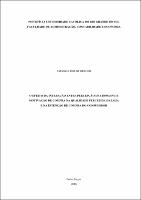| Share record |


|
Please use this identifier to cite or link to this item:
https://tede2.pucrs.br/tede2/handle/tede/6948| Document type: | Dissertação |
| Title: | O efeito da interação entre percepção de crowding e motivação de compra na qualidade percebida da loja e na intenção de compra do consumidor |
| Author: | Dreger, Amanda Rolim  |
| Advisor: | Espartel, Lélis Balestrin |
| Abstract (native): | A alta densidade de clientes é um problema comum enfrentado no dia a dia do varejo. A percepção dessa densidade em um nível que passa a causar sensações de desconforto chama-se percepção de crowding. Esta se caracteriza por ocorrer quando o espaço demandado pelo indivíduo é maior que o espaço que este de fato dispõe. Quando o sujeito chega a este ponto, percebendo crowding, ele tem uma série de sensações desagradáveis psicológicas, cognitivas e até mesmo fisiológicas. Esta experiência pode fazer com que o consumidor abandone a loja, não retorne e produza boca-a-boca negativo a respeito da mesma. Esta pesquisa procurou abordar as conceituações e aplicações empíricas deste fenômeno, bem como relacioná-lo com outra variável que também ressoa no universo de consumo: a motivação de compra. Com o intuito de descobrir se existe uma interação entre essas duas variáveis, foram realizados dois estudos experimentais, tendo como variáveis dependentes, a qualidade percebida e a intenção de compra. O primeiro estudo confirmou o efeito principal, demonstrando a tendência de que quanto maior for a percepção de crowding menor será a qualidade percebida da loja e a intenção de compra do consumidor. No segundo estudo, testou-se a interação entre o crowding e o tipo de motivação, hedônica ou utilitária. Os resultados demonstraram que existe uma moderação da motivação de compra na relação entre a percepção de crowding e a intenção de compra, mas não entre a percepção de crowding e a qualidade percebida. Apesar de ocorrer interação no caso da intenção de compra, este resultado também não se comportou conforme o esperado: na presença da baixa percepção de crowding, os sujeitos com motivação utilitária tiveram maior intenção de compra do que os consumidores motivados hedonicamente. Reflexões sobre o conceito e a forma de manipulação e mensuração das variáveis envolvidas, são feitas, bem como, ponderações e considerações finais a respeito dos resultados e das hipóteses confirmadas ou refutadas. Ao final, são destacadas algumas limitações dos estudos realizados e são apontadas oportunidades de pesquisa futuras. |
| Abstract (english): | High density is a common issue faced in retailing’s daily routine. The perception of this density at a level that starts causing feelings of discomfort is called perception of crowding. This is characterized by occur when space demanded by the individual is greater than the space that is available to him. When the person reaches this point, realizing crowding, he has a number of unpleasant sensations in psychological, cognitive and even physiological terms. This experience can make the consumer leave the store, not returning and produce negative word-of-mouth. This research sought to address the concepts and empirical applications of this phenomenon and relate it to another variable that also resonates in consumer universe: buying motivation. In order to find out if there is an interaction between these two variables, two experimental studies were conducted, with perceived quality and purchase intention as dependent variables. The first study confirmed the main effect, showing the tendency that the higher the crowding perception, less quality of the store will be perceived and less purchase intention the consumers will show. In the second study, the interaction between crowding and type of motivation, hedonic or utilitarian, was tested. The results showed that buying motivation acts like a moderator in the relationship between crowding perception and purchase intention, but not between perceived crowding and perceived quality. Although interaction occurs for purchase intention, this result also didn’t behave as expected: in the presence of low crowding perception, subjects with utilitarian motivation had higher purchase intention than consumers with hedonic motivation. Reflections on the concept and forms of manipulation and measurement of the involved variables are made, as well as deliberations and final considerations regarding the results and hypotheses confirmed or refuted. Lastly, we highlighted some limitations of the studies and identified opportunities for future research. |
| Keywords: | COMPORTAMENTO DO CONSUMIDOR MARKETING PESSOAL ADMINISTRAÇÃO DE EMPRESAS |
| CNPQ Knowledge Areas: | CIENCIAS SOCIAIS APLICADAS::ADMINISTRACAO |
| Language: | por |
| Country: | Brasil |
| Publisher: | Pontifícia Universidade Católica do Rio Grande do Sul |
| Institution Acronym: | PUCRS |
| Department: | Faculdade de Administração, Contabilidade e Economia |
| Program: | Programa de Pós-Graduação em Administração e Negócios |
| Access type: | Acesso Aberto |
| URI: | http://tede2.pucrs.br/tede2/handle/tede/6948 |
| Issue Date: | 30-May-2016 |
| Appears in Collections: | Programa de Pós-Graduação em Administração e Negócios |
Files in This Item:
| File | Description | Size | Format | |
|---|---|---|---|---|
| DIS_AMANDA_ROLIM_DREGER_COMPLETO.pdf | Texto Completo | 1.1 MB | Adobe PDF |  Download/Open Preview |
Items in DSpace are protected by copyright, with all rights reserved, unless otherwise indicated.




